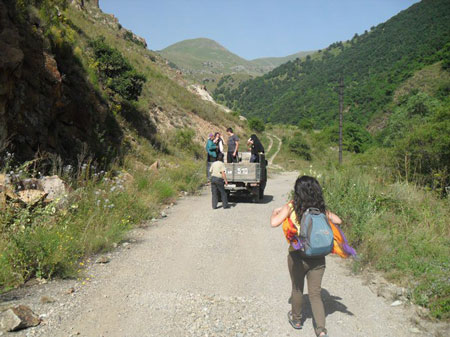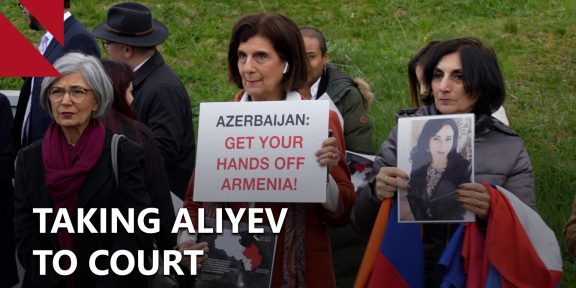 The funds raised during the Hayastan All-Armenian Fund’s 2013 Telethon in November of this year will be earmarked for the construction of a 114-kilometer stretch of the Vardenis-Martakert highway. This decision was taken on May 30 during the annual meeting of the Fund’s Board of Directors in Yerevan. But the timely completion of the highway could be dependent on finding additional benefactors to fund this second, better quality road connecting Armenia and Artsakh, which will pass through Karvajar.
The funds raised during the Hayastan All-Armenian Fund’s 2013 Telethon in November of this year will be earmarked for the construction of a 114-kilometer stretch of the Vardenis-Martakert highway. This decision was taken on May 30 during the annual meeting of the Fund’s Board of Directors in Yerevan. But the timely completion of the highway could be dependent on finding additional benefactors to fund this second, better quality road connecting Armenia and Artsakh, which will pass through Karvajar.
It is important to note that within the context of the Nagorno-Karabakh peace process, Karvajar is one of the most contentious issues. During the negotiations in 2006 in Rambouillet, near Paris, that were presided over by then French President Jacques Chirac, it was failure to agree on Karvajar that prevented the parties to the conflict moving forward. The Armenian side insisted that the return of Karvajar should not be linked to the timeframe for a potential referendum in Nagorno Karabakh on the region’s future status.
Almost two years later, at the end of November, 2007, the OSCE Minsk Group co-chairs presented a new written proposal in Madrid, where Karvajar was one of the pivotal issues. Because the Madrid document is no longer confidential and has been partially published in the press, we are citing in its entirety the passage which refers to Karvajar. For understandable reasons, the Azerbaijani toponym Kelbajar is used in that document.
“Armenian forces will withdraw from all territories of the former Nagorno Karabakh Autonomous Oblast. Armenian forces will be withdrawn from the region of Kelbajar. Limited troops will be deployed in those territories which an International Transition Committee will decide upon until the signing of a peace agreement. The supervision of the region of Kelbajar will be realized by an international transition committee which will include representatives of Armenia and Azerbaijan. The Committee will undertake international monitoring of the Kelbajar region. Withdrawal of the population of Kelbajar will be encouraged. Displaced Azerbaijanis will return to Kelbajar following the signing of a peace agreement,” the document states.
Road through Karvajar, Stronger Position
The construction of a new highway through Karvajar means that the Armenian position in the negotiating process will be strengthened. It is important to note that a stretch of road linking Vardenis and Martakert via Karvajar already exists, but it is not passable during the winter months.
Today, the only major artery that connects Artsakh to Armenia is the Goris-Stepanakert highway built in the 1990s, which was also financed by the Hayastan All-Armeniann Fund.
It is not yet clear how long construction of the Vardenis-Martakert highway will take. If the All-Armenian Fund has to shoulder the entire cost, then the funds from this year’s telethon will not be enough. On the other hand, taking into consideration the strategic significance of that highway for Artsakh, perhaps it will be possible to convince the Diaspora, including wealthy Diasporan benefactors, that the project is vital, and so should be completed in as short a time as possible, ideally within one year.
Why Now?
Anybody who looks at a map will understand why this project is so important. Which raises a further question – why is it only today that the All-Armeniann Fund has taken such a decision?
According to our information, the decision to build the Vardenis-Martakert stretch of highway initially encountered opposition from certain leading Fund members. The reason was not because they cannot see the importance of a second road connecting Artsakh to Armenia or because they were not conscious of its strategic importance, but because the construction of that road would be financially advantageous to private companies which, it was argued, should therefore contribute to cost of construction.
In June 2012, the Nagorno-Karabakh government approved an application by Base Metals Company to begin extracting copper and molybdenum at the Kashen Mine in the villages of Vardadzor, Nerkin Horatagh and Jankatagh in Martakert district. The Base Metals Company has for years been the largest taxpayer in Artsakh thanks to its activities at the Drmbon Mine. The Vallex Group, which owns Base Metals, will invest 80 million USD in the project. It is envisaged that they will mine 17 million tons of ore annually, which they will then transport to the Zod train station in the neighboring city of Vardenis via the Vardenis-Martakert highway being built by the All-Armeniann Fund. From Vardenis, it will be transported by train to the Alaverdi Copper Smelter.
This is why some All-Armeniann Fund representatives were initially against the project. They argued that those who stand to make millions of dollars in profit from the expanded Kashen Mine operations should also invest in construction of the highway. If Vallex and its subsidiary company Base Metals had been one of the largest donors to the All-Armeniann Fund’s Telethon 2013, this could have been justified. With the total cost of constructing the new Vardenis-Martakert passage expected to be approximately 30 million USD, then those who stand to make millions of dollars should donate at least half that amount.
In the final analysis, regardless of the motives, the strategic importance of the Vardenis-Martakert highway for the security of Armenia and Artsakh is indisputable.
Tatul Hakobyan
Photo: asbarez.com















